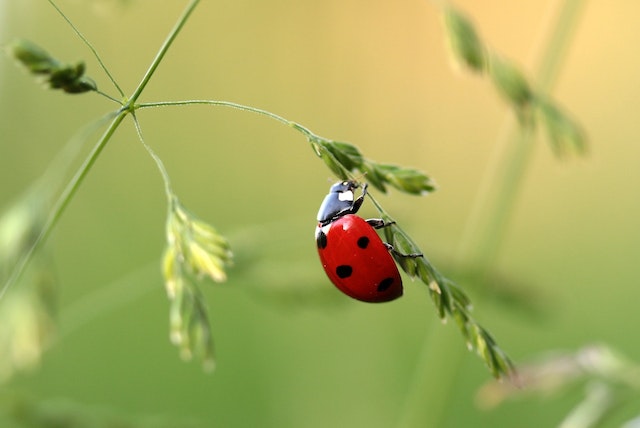
Why do insects have an exoskeleton? To stop them drying out, for protection, for support, and to help them sense their surroundings.
An exoskeleton is a hard skeleton that covers the body of an insect. Animals that have an internal skeleton, like us, have an endoskeleton. An exoskeleton is made of chitin, which is a polysaccharide, a type of carbohydrate. It is very similar to the cellulose that keeps plants rigid. The chitin is also made stronger with various minerals. These exoskeletons are quite heavy because of the material they are made from, but their strength makes the extra weight worthwhile. Obviously, insects aren’t the only creatures that have exoskeletons. Spiders, shellfish, crustaceans, and snails also have an exoskeleton. Snails are slightly different in that their exoskeleton doesn’t completely cover their body.
Because the exoskeleton is hard, it cannot grow with the insect. When we grow, our flesh, our skin, our organs, and our bones all tend to grow at the same time. Insects cannot do this, so once they have grown as much as their exoskeleton allows, most insects will shed it. They do this by basically breathing in as much as they can. They suck in air, pumping up their body, and cracking the exoskeleton enough that they can wriggle free of it. Their new exoskeleton will have grown, but it will still be a very soft shell, and they will need to hide somewhere to let it harden. They are very vulnerable during this time.
So, why do insects have an exoskeleton? One of the biggest reasons is so that they don’t dry out. Our skin is a waterproof layer and it keeps water both inside us and outside of us. Without our skin, our muscles would dry out. The same is true of an insect. The exoskeleton has a layer of waxy molecules. This makes it a water-impermeable barrier, which means the water from inside the insect cannot escape through it, and water from outside cannot get into the insect.
They also have an exoskeleton for protection. This works in several ways. The first type of protection is against microorganisms, such as fungi, viruses, parasites, and other dangers. The waxy molecules that stop water getting in and out of the shell also prevent any of these organisms from getting in. The second type of protection is structural. The chitin that makes up the exoskeleton can be very hard, making it difficult for some predators to get at the soft animal inside. Some animals have learnt to use tools to crack open the skeletons. And the third type of protection is through camouflage. The pigments that the insects use to hide, or to scare off predators are made in the exoskeleton.
The exoskeleton also serves to support the insect. They obviously support the insect by holding everything in, but they support the insect’s movement as well. Our muscles are attached to our bones with tendons and ligaments. Insect muscles attach directly to the exoskeleton. This gives them a huge area to attach to and, because the exoskeleton is made up of jointed plates, it allows them to have a very large range of movement. The exoskeleton has ridges that the muscles attach to. They are called apodemes and they create an attachment that is six times stronger than the tendons that attach our muscles to our bodies. They are also able to store elastic energy, which is why many insects can jump as high as they can.
Insects have receptors between the plates of their exoskeleton called campaniform sensilla. Their job is to detect deformations and strain on the exoskeleton. They are incredibly sensitive and they give the insects very fine control over their movement. Engineers are currently trying to work out how they can copy these detectors to use in robots.
The last main reason that insects have an exoskeleton is to sense the world around them. They have touch sensors in their legs and taste and smell sensors near their mouths. They have chemoreceptors in their exoskeleton that can detect the presence of different chemicals, for example, bees can detect pollen. They can detect the movement of the air and subtle vibrations. Spiders are able to detect the vibrations of their prey. A lot of these things are detected by mechanoreceptors, which are tiny hairs on the exoskeleton.
Exoskeletons are very heavy and they potentially slow insects down, but they have more advantages than disadvantages, which is why evolution has kept them. And this is what I learned today.
Sources
https://www.merriam-webster.com/dictionary/apodeme
https://www.sciencedirect.com/topics/agricultural-and-biological-sciences/exoskeleton
https://www.billnye.com/the-science-guy/insects
https://en.wikipedia.org/wiki/Exoskeleton
https://en.wikipedia.org/wiki/Chitin
https://animals.mom.com/insects-skeleton-outside-body-9265.html
https://study.com/learn/lesson/exoskeleton-advantages-examples.html
https://socratic.org/questions/what-are-the-advantages-and-disadvantages-of-an-exoskeleton
https://www.jstor.org/stable/24993274

[…] about 1,000 spatulae. The setae and spatulae are made of chitin, which is the same substance the exoskeleton of insects is made of. Each setae is about 100th of a millimeter in diameter. These hairs cover the […]
[…] are invertebrates, which is a cold-blooded animal with no backbone. They have an exoskeleton and they are made of multiple segments. They come from the animal group anthropoda, which are […]